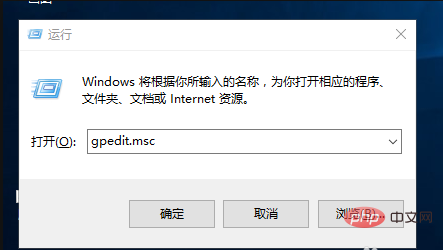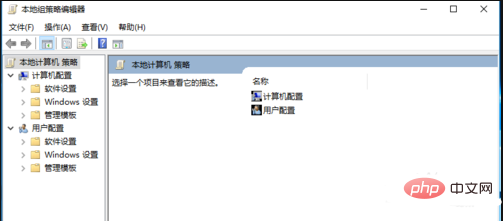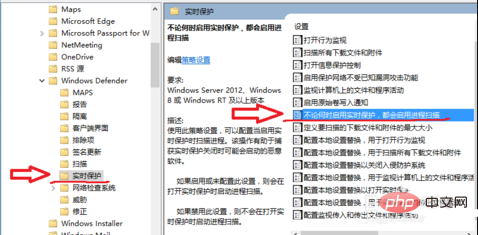What process is antimalware? Can it be turned off?
Antimalware is a process of Windows Defender, the built-in anti-virus software of Win10. It is a normal system process. Its function is to automatically scan the hard disk and files for removal, isolation and prevention of spyware, etc. . The antimalware process can be shut down. How to turn it off: 1. Open Windows Defender, exclude non-system disks from automatic scanning, and then turn off startup process scanning; 2. Disable Windows Defender, etc.

The operating environment of this tutorial: Windows 10 system, Dell G3 computer.
What is the process of antimalware
Antimalware is a process of win10’s built-in anti-virus software windows defender, the full name is “Antimalware Service Executable”.
Antimalware is a normal system process. The specific name of the process is MsMpEng.exe. The general size is 15.6KB and the location is C:\Program Files\Windows Defender. The reason why it occupies a high amount of system resources when booting is generally This is because it automatically scans the hard drive and files for removal, isolation and prevention of spyware, etc.
Can the antimalware process be shut down?
The antimalware process can be shut down.
Turn off method 1: Turn off startup process scanning and exclude scanning of non-system disks
Open Windows Defender, click the "Settings" option, click on the left panel to switch to "Excluded files and locations" " option to exclude non-system disks from automatic scanning through "Browse" and "Add".

Turn off Method 2: Disable Windows Defender
Open Windows Defender, in the settings interface, click "Administrator" on the left and select "Enable this Uncheck the application.

Turn off Method 3: Local Group Policy
1. Open "Run".

#2. Then enter: gpedit.msc in run.

#3. After confirming, the Local Group Policy Editor will open.

#4. Open the red lines in order: Management Templates----Windows Components----Windows Defender.

#5. Find "Real-time Protection" under Windows Defender. Then double-click the mouse on the right side of "Whenever real-time protection is enabled, process scanning will be enabled.

6. Select Disabled on the pop-up settings page, save and close antimalware service executable.
For more related knowledge, please visit the FAQ column!
The above is the detailed content of What process is antimalware? Can it be turned off?. For more information, please follow other related articles on the PHP Chinese website!

Hot AI Tools

Undresser.AI Undress
AI-powered app for creating realistic nude photos

AI Clothes Remover
Online AI tool for removing clothes from photos.

Undress AI Tool
Undress images for free

Clothoff.io
AI clothes remover

AI Hentai Generator
Generate AI Hentai for free.

Hot Article

Hot Tools

Notepad++7.3.1
Easy-to-use and free code editor

SublimeText3 Chinese version
Chinese version, very easy to use

Zend Studio 13.0.1
Powerful PHP integrated development environment

Dreamweaver CS6
Visual web development tools

SublimeText3 Mac version
God-level code editing software (SublimeText3)

Hot Topics
 Explain what the explorer.exe process is
Feb 18, 2024 pm 12:11 PM
Explain what the explorer.exe process is
Feb 18, 2024 pm 12:11 PM
What process is explorer.exe? When we use the Windows operating system, we often hear the term "explorer.exe". So, are you curious about what this process is? In this article, we will explain in detail what process explorer.exe is and its functions and effects. First of all, explorer.exe is a key process of the Windows operating system. It is responsible for managing and controlling Windows Explorer (Window
 What is the process of com surrogate?
Sep 14, 2022 pm 02:56 PM
What is the process of com surrogate?
Sep 14, 2022 pm 02:56 PM
"com surrogate" is the process of "C:\Windows\System32\dllhost.exe"; when this process occurs, it usually means that the "COM+" component stops working. This process takes up a lot of space and even does not respond directly. This is because the computer is loading the file icon. Sometimes a problem occurs, causing the computer to become stuck. You can solve the stuck problem in the computer properties settings.
 What kind of process is ccsvchst.exe?
Feb 19, 2024 pm 11:33 PM
What kind of process is ccsvchst.exe?
Feb 19, 2024 pm 11:33 PM
ccsvchst.exe is a common process file that is part of the Symantec Endpoint Protection (SEP) software, and SEP is an endpoint protection solution developed by the well-known network security company Symantec. As part of the software, ccsvchst.exe is responsible for managing and monitoring SEP-related processes. First, let’s take a look at SymantecEndpointProtection(
 How to properly kill zombie processes in Linux
Feb 19, 2024 am 10:40 AM
How to properly kill zombie processes in Linux
Feb 19, 2024 am 10:40 AM
In Linux systems, zombie processes are special processes that have been terminated but still remain in the system. Although zombie processes do not consume many resources, if there are too many, they may cause system resource exhaustion. This article will introduce how to correctly remove zombie processes to ensure the normal operation of the system. 1Linux zombie process After the child process completes its task, if the parent process does not check the status in time, the child process will become a zombie process. The child process is waiting for confirmation from the parent process, and the system will not recycle it until it is completed. Otherwise, the zombie process will continue to hang in the system. To check whether there are zombie processes in the system, you can run the command top to view all running processes and possible zombie processes. The result of the ‘top’ command can be seen from the figure above in Linux.
 How to stop Task Manager process updates and kill tasks more easily in Windows 11
Aug 20, 2023 am 11:05 AM
How to stop Task Manager process updates and kill tasks more easily in Windows 11
Aug 20, 2023 am 11:05 AM
How to Pause Task Manager Process Updates in Windows 11 and Windows 10 Press CTRL+Window Key+Delete to open Task Manager. By default, Task Manager will open the Processes window. As you can see here, all the apps are endlessly moving around and it can be hard to point them down when you want to select them. So, press CTRL and hold it, this will pause the task manager. You can still select apps and even scroll down, but you must hold down the CTRL button at all times.
 Detailed explanation of Linux process priority adjustment method
Mar 15, 2024 am 08:39 AM
Detailed explanation of Linux process priority adjustment method
Mar 15, 2024 am 08:39 AM
Detailed explanation of the Linux process priority adjustment method. In the Linux system, the priority of a process determines its execution order and resource allocation in the system. Reasonably adjusting the priority of the process can improve the performance and efficiency of the system. This article will introduce in detail how to adjust the priority of the process in Linux and provide specific code examples. 1. Overview of process priority In the Linux system, each process has a priority associated with it. The priority range is generally -20 to 19, where -20 represents the highest priority and 19 represents
 Why do processes in Linux sleep?
Mar 20, 2024 pm 02:09 PM
Why do processes in Linux sleep?
Mar 20, 2024 pm 02:09 PM
Why do processes in Linux sleep? In the Linux operating system, a process can become dormant due to a number of different reasons and conditions. When a process is in a dormant state, it means that the process is temporarily suspended and cannot continue execution until certain conditions are met before it can be awakened to continue execution. Next, we will introduce in detail several common situations when a process enters hibernation in Linux, and illustrate them with specific code examples. Waiting for I/O to complete: When a process initiates an I/O operation (such as reading
 Analyze why Linux processes enter sleep mode
Mar 21, 2024 am 11:06 AM
Analyze why Linux processes enter sleep mode
Mar 21, 2024 am 11:06 AM
To analyze why a Linux process enters sleep mode, specific code examples are needed. In Linux systems, processes enter sleep mode for many reasons. Sleep mode includes waiting for resources, waiting for signals, and waiting for events. This article will analyze in detail why the Linux process enters sleep mode from these aspects, and explain it through specific code examples. During the execution of the waiting resource process, you may need to access some shared resources, such as files, network connections, memory, etc. When a resource is occupied by other processes or locked





